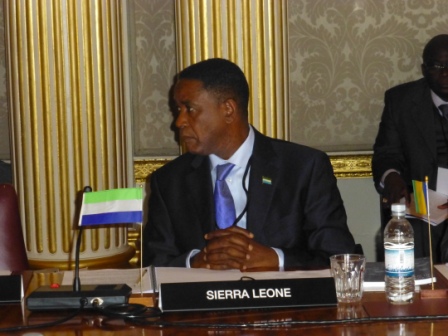Oil and food security for the Gulf of Guinea (guest commentary)
The Gulf of Guinea has emerged as the second largest pool of commercial petroleum resources in the world and recently surpassed the Persian Gulf as America’s largest supplier of crude oil. African oil tends to be of high quality, low in sulfur, and 2,000 miles closer to U. S. refining centers without maritime transit chokepoints. Unlike security concerns associated with Middle Eastern oil, offshore oil production is easier to protect from ground turmoil. Understandably, the Gulf of Guinea is a nexus of concern for U.S. energy policy since the region will supply 25 percent of its crude oil by 2015.
As reported by the Associated Press in 2007: “Just a few years ago, the U.S. military was all but absent from the oil-rich waters of West Africa’s Gulf of Guinea. This year, it plans to be there every day”. Consequently, the Pentagon has forged both bilateral and regional military partnerships with every African nation in the region with the exception of the Ivory Coast.
Investing in Oil Security
Historically, the concept of security in many African nations has been primarily land-centric without a maritime dimension. Late last year the Atlantic Council released “Advancing U.S. African and Global Interests: Security and Stability in the West African Maritime Domain”. This report recommends the development of a “regional maritime security network” with U.S. and international security assistance efforts, including planning support, asset donation, and training.
A regional maritime security network would help secure oil supplies in the Gulf of Guinea for quelling America’s concerns while strengthening cooperation and geopolitics for the region’s political stability and economic prosperity. However, such a network should have an overarching “strategy” with “security” a subset component in the context of defense. A comprehensive maritime strategy should also include: sustainable use and development of the maritime domain; environmental and resource conservation; and most importantly, food security.
Investing in Food Security
The ability to produce food fast and economically is becoming the new investment opportunity as a global hedge against starvation. Oil-rich Arab nations are buying foreign land to overcome the local twin deficits of food and water in the arid Middle East, which imports over 80 percent of its food. As a result, the global demand for farmland has increased significantly since the 2008 food crisis and more than 70 percent of such demand has been for African lands intended for traditional terrestrial farming. Ironically, 70 percent of our planet is covered with seas offering more fecundity for economical protein production without depleting scarce water resources.
According to the Food and Agriculture Organization of the United Nations (FAO), only about 2 percent of the world’s food is currently obtained from the sea with traditional marine fishing annually producing about 100 million tons. Simply maintaining current per capita consumption will require 1.6 million tons more fish every year by 2015, increasing to 4.2 million tons by 2030. Since 80 percent of the world’s fishing stocks are fully or over exploited, sea farming or marine aquaculture may be the only answer for filling the gap. Worldwide, half the fish consumed by humans are now produced by fish farms. Harvesting the sea is the fastest-growing form of food production in the world promising a “Blue Food Revolution” based upon greater productivity of the sea than that of land for feeding the future.
As a source of animal protein, farmed fish are a godsend in a grain-limited world. The estimated amounts of grain are far more economical for producing fish than for beef or pork and on par with that of chicken. Whereas seven kilograms of grain are required to produce each kilogram of beef, and four for each kilogram of pork, only two kilograms of grain are needed to produce one kilogram of either chicken or fish.
In terms of how much of an animal is actually consumed by people, fish also trump: approximately 65 percent of the raw weight of finfish is eaten, compared with 50 percent of raw weight of chicken and pigs and 40 percent of sheep. This is because fish are supported by water so they don’t have to put as much of their growth energy into bone structure resulting in greater edible mass. Fish are also low in fat, cholesterol, and omega-3 fatty acids which helps reduce blood clotting and in turn the risk of heart attacks – all notable advantages over other meats.
Consider the thousands of gallons of freshwater needed to produce a pound of food on land that could be saved by sea production of animal and plant species not requiring precious and finite freshwater and diminishing land resources. Furthermore, marine aquaculture is less susceptible than agriculture to the effects of climate change. The rule of thumb among crop ecologists is that for every one degree Celsius rise in temperature above the growing season optimum, farmers can expect a 10 percent decline in yields. Moreover, as global temperatures are rising, water tables are falling from increased pumping to support agriculture irrigation on a hotter planet. Marine aquaculture offers a sustainable solution for when the water-based agriculture bubble bursts with the depletion of non-renewable aquifers.
Investing in Marine Aquaculture
300 million people, half living along the coast, populate the 16 states ensconcing the Gulf of Guinea and the livelihoods of millions are dependent on the fishing sector. Average per capita fish consumption is estimated at 20-25 kilograms, about double that of the world average, and marine fish provide over 80 percent of the supply. Annually, the region catches about 200,000 tons of fish, which is the same amount that it imports. Amazingly, there are no plans for the region to exploit its 2.6 million square kilometers of sea with a sustainable marine aquaculture industry.
The Gulf of Guinea boasts one of the most bountiful Large Marine Ecosystems (LME) supporting significant biomasses of plankton, tuna, sardines, mackerel, shrimp and other species. However, the Gulf of Guinea’s LME is over-fished and terribly stressed creating a crisis for those who depend on fisheries for their livelihoods and jeopardizing food security for the region.
Since the Gulf of Guinea’s wild fisheries have reached or exceeded their maximum sustainable harvest, marine aquaculture should be given serious consideration for food security. Offshore marine farming operations contemplates cages deployed in pristine waters having optimum currents for cultivating “free range” fish not sequestered in polluted bays and estuaries. This concept softens the environmental footprint and reduces reliance on wild fishery resources.
The oil-producing littoral states have huge potential for diversifying their emerging economies by investing the capital generated beneath their oil-rich waters into sustainable fish farms suspended in offshore cages. By developing a modern marine aquaculture industry, the region could become a major producer of seafood for feeding its population and generating foreign exchange by feeding others. The Gulf of Guinea possesses the resources to capitalize on the sustainable Blue Food Revolution as its vast non-renewable petroleum resources are depleted.
“With Earth’s burgeoning human populations to feed, we must turn to the sea with new understanding and new technology,” Cousteau presciently predicted in his 1973 television show The Undersea World of Jacques Cousteau. “We need to farm it as we farm the land.”
By Phil Cruver. Phil ca be reached at phil@kzoseafarms.com
Stay with Sierra Express Media, for your trusted place in news!
© 2011, https:. All rights reserved.






